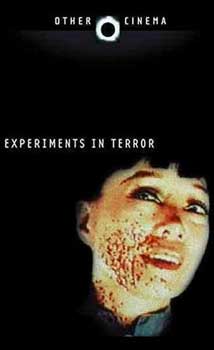The dvd Experiments in Terror (2003) consists of six short films by six independent or perhaps amateur directors, mostly of the avante gard variety, plus some trivial "extras." I'm a huge fan of short subjects of fantastic content & really looked forward to this collection. Though it wasn't as rewarding as i had hoped, I got enough out of it that I'm not sorry I took the time.
But neither did it provide moments of thrilling discovery as I've had when stumbling on such wonderful short films as, oh, how about Gaelle Denis's Paradise City (2004), or Finbar Mallow's The Extra-ordinary Light-bulb (2006), or Jennifer Kent's Monster (2005), or Leon Prochnick's The Existentialist (1963), Daniel Strange's Medea (2003), or the short films of Guy Madden.
Or something on the order of actual genius as evidenced by Jan Svankmajer or the brothers Quay or Maya Deren's Meshes of the Afternoon (1943).
Experiments in Terror was much more like attending an Amateur Film Festival, & frankly it should've been a lot better since it draws from as far back as the 1960s for obscure short films. And there really has been better stuff than this along the last 40 years for crine out loud, great stuff that has fallen by the wayside only because of the limited options for keeping short films in the public eye.
Still, it wouldn't be possible to even be a fan of independent short films without an ability to find pleasures even in a lot of the duds & also-rans.
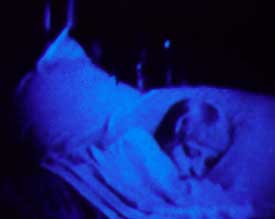 The highly experimental Tuning the Sleeping Machine (1996) appears to have been spliced together from a lot of found film footage & spoiled/damaged footage with very little rhyme or reason. It begins with a blue village scape, flickering as though videotaped right off a television screen (it's indeed stolen from the 1931 film Svengali). The camera pans into the flickering room of a sleeper. Presumedly everything that follows is in this sleeper's dream.
The highly experimental Tuning the Sleeping Machine (1996) appears to have been spliced together from a lot of found film footage & spoiled/damaged footage with very little rhyme or reason. It begins with a blue village scape, flickering as though videotaped right off a television screen (it's indeed stolen from the 1931 film Svengali). The camera pans into the flickering room of a sleeper. Presumedly everything that follows is in this sleeper's dream.
Unfocused strobing images are frequently nothing but stains & blobs. Mixed into the mess are bits of vintage film footage from Curse of Frankenstein, The Invisible Man, Svengali, bits of train travel footage as though the film is going somewhere, & random faces. Now & then we see the floating dreamer.
Because it's so short it's tolerable, but nothing of its content seems to have any actual purpose beyond the idea that dreams don't make sense.
Since my own dreams actually do make a lot of sense, even if only in an expressionist manner, I just didn't buy that "it's a dream" was a good excuse for presenting only chaos. There's certainly no sense that Tuning required a lot of thought or planning to get a specific effect.
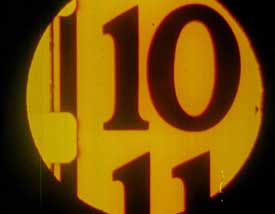 The two excuses for not making sense, first that "it's avante gard" & second "it's a dream," afflict other films of this small collection, & may even be regarded as a unifying theme of the selection, since at least three of the six films are of similar tone & calibre. The other chaos-driven experiments are a bit more effective than Tuning the Sleeping Machine.
The two excuses for not making sense, first that "it's avante gard" & second "it's a dream," afflict other films of this small collection, & may even be regarded as a unifying theme of the selection, since at least three of the six films are of similar tone & calibre. The other chaos-driven experiments are a bit more effective than Tuning the Sleeping Machine.
This similarity from different years from amateur directors presumedly unknown to one another is the chief condemnation. Nothing alleging to be an experiment should fit so tidily into so specific a type, conveying dirth of originality. Fact is, these films are vastly less original than their makers may have intended, & each is much more defined by the similarity of the filmmakers' limitations not only of funds but of talent.
Journey to the Unknown (2002) shows a theater marquis gaudilly colorized & negative; a figure walking in the street, passing a window display of manikins; everything oddly colored & the images vague. We see letters & count-down numbers such as start off a lot films; there are faces, a doll; everything flashing by in chaoitic manner. Reappearance of the theater marquis seems to be the filmmaker insisting "looky, I made a movie."
If you read the filmmaker's discription of the "plot," then the manikins glimpsed by the walking figure are siren temptresses who call a voyeuristic man into a haunted cinema where he gets his comeuppance. Very little in the actual film supports this discription, so I'll review what I saw rather than what I was told I was supposed to see.
With harsh sound & suspense-film music, the one thing this film elucidates is how much of the mood & effect in any film is a stunt & not something that grows out of content. Journey has very little story content per se, & no narrative cohesion. It nevertheless delivers a high dose of suspense just by rapid cuts to fast motion & a soundscape designed for tension & to startle. How many films that do have coherent content only seem to be effective because of the sound? Many, no doubt.
The horrific image of a car bashing over & over again into a chain link fence may indicate the figure seen walking has been run over, & run over, & run over again, as in a ferocious scene from Wait Until Dark (1967). But the unclarity of the cinematography makes nothing certain.
Though I didn't think this little film was a great success, I was impressed by how much tension is built into the chaos.
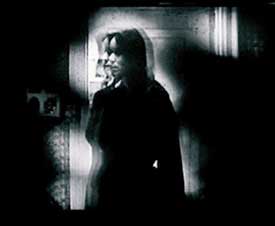 A third descent into "nonsensical sense" is the Austrian production Outer Space (1999), ten minutes of flickering light & shadow in black & white, the footage so darkened & damaged as to obscure everything, with swift intimations of a haunted house & a brutalized victim.
A third descent into "nonsensical sense" is the Austrian production Outer Space (1999), ten minutes of flickering light & shadow in black & white, the footage so darkened & damaged as to obscure everything, with swift intimations of a haunted house & a brutalized victim.
I watched it cold turkey, not knowing anything about it beforehand. In the strobing mishmash of images that have nothing whatsoever to do with outer space, I spotted an actress I always like, Barbara Hershey. But disbelieving Hershey would appear in such a no-budget & seemingly pointless experiment, I convinced myself it was a Barbara Hershey look-alike.
Slowly I realized I was watching rearranged & savagely stomped-on fragments from Hershey's excellent horror film, The Entity (1981). I was slow to identify the footage because it's so optically altered & images pass so swiftly that it looks like it was spliced together from unrestored fragments of a nearly destroyed silent film of the 1920s.
The soundtrack gets noisier & more chaotic as it progresses, & is terrifying with only hints of specific content or narrative structure. Like Journey to the Unknown it relies on its herky-jerky shock-editing & startling noises, rather than definite event, to achieve an audience reaction of tension or horror.
Once you start thinking The Entity, you can tell it's about an invisible demon raping & attacking a young woman. If you never recognize the source material, however, it's not likely the meaning would ever surface.
Of the three most out-there avante gard films of the collection, this is the only one I regard as a success, as it engenders a good deal of unease while avoiding narrative sense, achieving a genuine nightmare sensibility.
It has been called a "manufactured film" because none of the footage is original to Tscherkassky, & none of its tension is "real" in any sense of growing out of a narration, but is purely "cinematic tricks" & informs us that a movie needs no original content, no rational sense or story, no acting, not even coherent visuals -- but needs only jarring sounds & confusing images, to captivate an audience.
Such films reduce the viewer to cave people around a campfire responding with emotion sans intelligence, instead of a storytelling circle that engages the imagination.
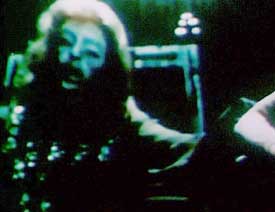 The Virgin Sacrifice (1969) begins as a straightforward narrative film so badly acted that it argues in favor of the rest of the collection's avoidance of narrative.
The Virgin Sacrifice (1969) begins as a straightforward narrative film so badly acted that it argues in favor of the rest of the collection's avoidance of narrative.
A mute young woman named Cindy comes to look at an apartment to share with two other young women, Nicky & Dawn. They immediately welcome the mute into the fold & nonchallantly mention they are Satanists & she's welcome to come along to their next cult meeting. Impossible to know what Cindy's thinking but she seems okay with it.
It thereafter loses the narration & turns into something most resembling a Ken Anger film if Anger had ever made a film specifically for Anton LeVey's birthday party. It really could fob itself off as a Ken Anger film if it were a little more gay.
It's a random accumulation Satan-worship cliches & blood-spattered-on go-go girls, 'sixties psychedelics, & nekkid ladies. We catch glimpses of a a masked man & an old fart that did make me think of the Black Pope even before I found out Anton LeVey actually funded the darned thing.
We see ho-hum ritual bloodletting, & can assume more due to the film's title more than by what is shown, virgin sacrifice, though the filmmaker was oddly charry of showing the ultimate outcome.
There's also a warlock who creates cartoon whirligigs, followed by a really lovely section entirely animated, showing skeletons floating through a woodcut engraving of a cathedral & round & round a circular staircase. I almost wished the whole film were thrown away & the animated portion expanded, cuz that part was really weird & pretty & gave the impression of a filmmaker of serious merit.
This is not the entire film, as the negative was destroyed in a fire before the final edit. All that remains is the first nine minutes. Of this nine minutes, nothing except the animated portion suggests that something significant might have gotten burnt up. Even so, overall I did like this one, despite that it's so crappy, which is exactly how I've felt about Ken Anger.
copyright © by Paghat the Ratgirl
|
